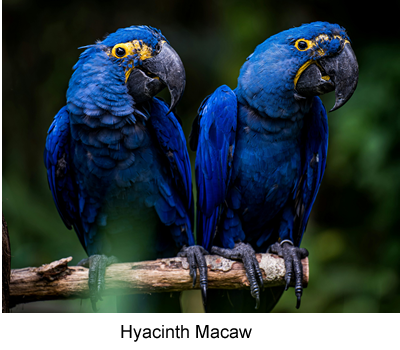 |
|
Name:
Hyacinth Macaw Classification:
Class: Aves
Order: Psittaciformes
Family: Psittacidea
Genus: Anodorhynchus
Species: A.
hyacinthinus
Size:
About 3 feet long. Characteristics:Long
body, large and powerful beak, wings and tail possess long feathers,
two scaly legs with three claws each. Status: Vulnerable. If you're feeling blue, you're probably having a bad day. If you're a hyacinth macaw, then it's normal to be blue! The hyacinth macaw is the largest of the macaws and the largest of all parrots. This blue bird is found in the woodlands, jungles, swamps, scrublands and palm groves of Brazil, Paraguay and Bolivia. Hyacinth macaws are social birds, living in flocks of six-to-twelve. They are active during the day and on moonlit nights. They are very noisy birds, making loud rarrree-arree sounds, especially when flying. Between their size (over three feet long) and their screeching, it's hard to miss a flock of them when they fly through the jungle! Hyacinth macaws use their powerful beaks to seek out various kinds of nuts, including macadamia nuts, Brazil nuts, palm nuts and coconuts (though that isn't a real nut). You could say that hyacinth macaws are nuts about nuts! They also eat certain kinds of seeds and drink nectar from unripe palm fruits. Like all parrots, hyacinth macaws are intelligent. They have even been known to use tools; sometimes a hyacinth will use a leaf or a piece of wood to prop up a harder nut, thus keeping it in place while it bites into it! Hyacinth macaws are old enough to reproduce around ten years old. They breed in July through December, or December through March depending on their location. A female will build a nest in a cliff face or trees, especially manduvi trees. The female will lay two-to-three eggs and incubate them for about a month before hatching. After that the chicks will stay with their parents for about 180 days before going on their own. Hyacinth macaws are currently classed as vulnerable by the IUCN. One of their primary threats is deforestation. Their habitat is being cleared away to make grazing land for cattle and growing land for soy. Illegal logging is also a threat. With the Brazil Forest Fires of 2019, this makes the situation for hyacinth macaws and many other animals all the more urgent. In addition to this, hyacinth macaws have been prized as pets. In the 1980s, as many as 10,000 hyacinth macaws were taken for the pet trade, selling for as high as $12,000! Their curious and noisy natures make them especially easy to capture. Hyacinth macaws are difficult to breed in captivity, which motivates dealers to capture more of them from the wild. Taking animals out of the wild harms the species as a whole! Remember: never buy a pet that has been captured from the wild! Fortunately, steps have been taken to protect this beautiful bird. Hyacinth macaws are protected in Bolivia and Brazil. They are also listed on CITES Appendix I, which bans commercial export of the species. Many organizations such as Parrots International and the World Wildlife Fund have programs to safeguard hyacinth macaws, and other organizations are helping to protect and restore the bird's habitat. It will take time and hard work, but it's safe to say that the hyacinth macaw has a fighting chance! To learn more about these birds and how to protect them, check out these websites: Parrots International,
Hyacinth Macaw Page-Dedicated to helping parrots through research and
conservation. World Wildlife Fund,
Amazon Page-See what the WWF is doing to protect the Amazon!
Want to do more? There are simple
things you can do RIGHT NOW to help!
photo credit: pexels-alteredsnaps |
|
|
|
|
||
|
Contact
Us
|
||||
|
Taproot
Guru © ALL RIGHTS RESERVED
|
||||